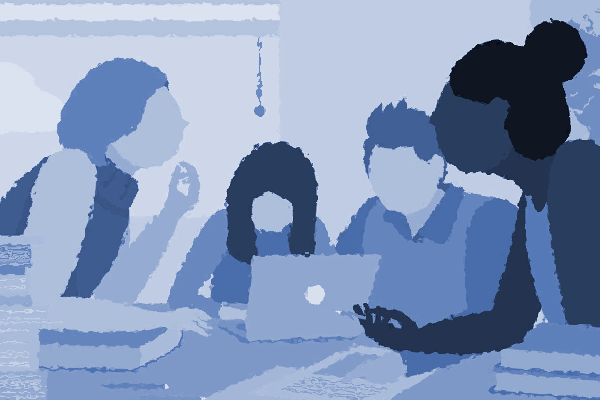
Pedagogical Partner Up Grants
We recognize that faculty have poured a great deal of time, energy, and creativity into their teaching in recent years. We have borne witness to faculty's excellent teaching across all modalities, and we want to provide avenues for faculty to share their contributions.
As a response to faculty feedback, we are excited to announce a call for applications for Partner-Up Grants of $2,000 for full-time faculty to participate in faculty-led learning pods focused on priority areas that emerged as topics from the faculty surveys. Each pod serves as a nexus for faculty to enhance their own pedagogical knowledge while sharing with colleagues.
The goal of Partner Up Grants was multi-fold: support faculty helping one another with pedagogy; disseminate ideas more broadly across the academic year; and make more visible the ways that faculty have navigated pedagogical challenges. Partner up pods determine the best dissemination strategy for their ideas that can range from generating resources for the SMU Keep Teaching site, conducting workshops with CTE, developing short videos, or making presentations at department meetings. Every pod receives ongoing assistance from CTE/OIT/Libraries.
Funding priorities included the following and were open to all full-time faculty:
- Representation across a wide range of pedagogical approaches (from discussion-based to lecture-driven; from creative exploration to objective exam learning)
- Faculty drawn across a variety of disciplines from all Schools and Colleges
- Focus on all teaching modalities
We created a simple online application that made it easy for faculty to apply. The link provided took faculty to the application that asked for a 250-word description of the area in which they were most interested and a 100-word description of ideas for disseminating what teams learned.
Pod Projects

Digital tools to foster discussion, engagement in hybrid and virtual Classrooms
POD MEMBERS: Stephen Grollman, German | Kristina Nielson, Music | Lauren Smart, Journalism.
PROJECT DESCRIPTION: Throughout the 2020-2021 school year, faculty have experimented real time with various methods to retain high-level engagement in these learning spaces, whether teaching in the hybrid model, hyflex, or fully virtual classrooms. This has brought challenges both to the teacher and the student, particularly in classrooms with high levels of discussion or engagement. In our research pod, the specific challenges included language learning, lecture engagement, and graduate-level discussion groups, both full classroom and breakout spaces. In this resource guide, you will find a collection of software, plug-ins and digital platforms with classroom applications. We have outlined where to acquire these tools, how to use these platforms, as well as shared the specific, anecdotal uses in our classrooms. We hope this is helpful and would be happy to answer any questions.

Alternate Types of Assignments with Technology
POD MEMBERS: LaShonda Eaddy, Corporate Communication & Public Affairs | Dan Moss, English | Rob Rouse, Teaching & Learning | Emma Annette Wilson, English.
PROJECT DESCRIPTION:Our goal was to explore and demonstrate new and alternative types of assignment for online and hybrid learning, leveraging Canvas-and Zoom-compatible technology. Additionally, we focused on types of assignment that would: 1) facilitate communication among students and instructors, and 2) allow students to demonstrate what they know in appropriate and interesting ways that we would not necessarily have used in our regular teaching. Our aim was to take advantage of working in online and hybrid environments to change the modalities in which students engage with their materials, presenting SMU’s teaching community of practice with examples of types of assignments that can be incorporated into future face-to-face and hybrid teaching models.

Supporting English Language Learners in Your Courses
POD MEMBERS: Emily Sharma, English | Richard Treat, English.
PROJECT DESCRIPTION: This website is intended to provide faculty members with pedagogical tips and tools for addressing the unique needs of English Language Learners (ELLs). Points of consideration include fostering an inclusive environment, communicating effectively, designing syllabi and course materials, and assessing students equitably. A quick video introduces the most salient points from the website, and downloadable sample rubrics illustrate some options for incorporating (or not incorporating) language proficiencies into assignment objectives in any discipline. Instructors will find that the principles of Universal Design that drive these discussions will, aptly, benefitallstudents in their courses as they promote practices that set up students to achieve optimal learning. In addition to considerations for their own courses, we provide faculty with Campus Connections—a directory of offices and individuals at SMU who stand ready to help support our ELLs in their academic endeavors. If instructors have questions or would like additional support, we encourage them to reach out to us at any time.

Feedback Strategies: Enhancing Learning and Connection Through Effective Feedback
POD MEMBERS: Jacqueline Fellows, Journalism | Brandon Mastromartino, Applied Physiology & Welness | Alexis McCrossen, History | Leticia McDoniel, World Languages & Literatures.
PROJECT DESCRIPTION: Get tips and strategies to strengthen connections with students in a virtual learning environment. Three self-guided modules include links, peer-reviewed resources and practical advice you can immediately use for three feedback loops: faculty-to-student, student-to-student and student-to-faculty. This resource was developed among a multi-disciplinary group of SMU faculty to improve student engagement. The approaches specifically address concerns related to teaching online but can also be applied in a traditional classroom setting.

Task-based projects and formative and summative forms of assessment
POD MEMBERS: Daniele Forlino, World Languages & Literatures (WLL) | Gizem Arslam, WLL | Gwendoline Aaron, WLL | James Batchelor, WLL | Kathy Hayes, Economics | Samantha Pergadia, English | Susana Adoboe, WLL.
PROJECT DESCRIPTION: This project focused on three areas of interest: academic integrity, assessments, and student engagement. Our main task has been the creation of a Canvas course where SMU faculty from different colleges anddisciplines can find information on those topics and share (through ongoing discussion forums) comments and additional materials, and actively participate in asynchronous discussions related to the main topics. In the first module of our Canvas course, we provide information on academic integrity from three resources: (1) resources from SMU's Dean of Students, (2) a review of the literature on academic integrity with examples of training tools from a number of universities and (3) additional communication tools on academic integrity. The second module first provides some principles for online assessment followed by some examples of assessment practices at SMU. Student engagement resources are found in the third module. Each module includes a discussion forum where faculty consulting the material can add comments or questions, or share additional resources. It is our intention to provide a workshop by the end of the summer in which we would like to present the Canvas course to SMU faculty.

Resources for Creating Course Content
POD MEMBERS: Crista DeLuzio, History | Liljana Elverskog, World Langages & Literatures | Robert Hunt, Global Theological Education | Steven Lindquist, Religious Studies | Amber Bemak, Film and Media Arts | Piyawan Charoensap-Kelly, Corporate Comm. ad Pub. Affairs | Wendy Wilson, Accounting.
POD DESCRIPTION: Our resources share faculty strategies for creating and organizing course content that is engaging, interactive, user-friendly, reusable, and applicable to synchronous, asynchronous, and hybrid learning modes. We start by providing a video with tips regarding setting up or improving a home studio workspace, we share a one-page document that outlines pros and cons of some lecture recording tools, we share a video with best practices for online discussion boards, we provide a pdf booklet with tips to create content with Playposit, we share a video with best practices for creating an engaging video, and how to create a 360 video site tour of a historical site or contemporary situations.

Engaged Classrooms for the 21st Century
POD MEMBERS: Stephanie Amsel, English | Paola Buckley, World Languages & Literatures | Jill DeTemple, Religious Studies | Bruce Levy, English | Beth Newman, English | Helen Reynolds, Economics.
POD DESCRIPTION: Before 2020, we had experience in overcoming physical obstacles such as poorly arranged furniture in a room. As the Pandemic starts to wind down, Flex and Remote formats have only added to our repertoire of skills. What follows are suggestions for creating spaces where students are more likely to connect with each other, with professors, and with course content; where they are more likely to undertake what Ken Bain dubbed “deep learning:” the intrinsically motivated approach to new knowledge that will stick with them, and that they will be able to use, for years to come.

Tips & Tricks for Online Learning
POD MEMBERS: Alexandra Pavlakis, Ed. Policy & Leadership | Kiersten Ferguson, Ed. Policy & Leadership | Meredith Richards, Ed. Policy & Leadership | Sondra Barringer, Ed. Policy & Leadership.
POD DESCRIPTION: Drawing on our expertise across programs, modalities, and both content and methods courses, we have provided a number of tips and tricks that helped us succeed in these challenging semesters. However, many of the ideas we highlight here are elements of universal course design and we hope will be helpful to ourselves and other faculty even beyond the pandemic.

Social Relationships and Wellbeing Within and Beyond the Classroom
POD MEMBERS: Alice Kendrick, Advertising | Andrea Laurent-Simpson, Sociology | Chris Logan, Psychology | Maryann Cairns, Anthropology | Nicolas Stersdorff-Cisterna, Anthropology.
POD DESCRIPTION: In this roundtable recording, five SMU professors from different disciplines discuss a variety of methods for facilitating student wellbeing. A Zoom roundtable recording features undergraduate interviewer Jason Jordan inviting participants to share pedagogical practices and results. The roundtable features: Maryann Cairns’ ethnographic methods class worked on early-pandemic research about loneliness, technology, human connection, and virtual spaces. Resulting research provided information both about pandemic connectedness, and how students coped with--and learned from--the socially-distant classroom. Alice Kendrick’s Advertising Research class studying their own deprivation of consumer experiences as the result of COVID-19 restrictions. Studying themselves and each other provided catharsis for their day-to-day frustrations. Andrea Laurent-Simpson’s approach to integrating information about COVID-19 with relevant course work as a means of providing both student catharsis and analytical skill set development in the classroom. Chris Logan’s Positive Psychology focuses on literature relating to flourishing, resilience, and community. The importance of connectedness on flourishing has been a theme across a variety of classes during the pandemic. Nicolas Sternsdorff-Cisterna’s Ethnographic Methods Class explores the ways in which research with human subjects can be conducted and adapted to the limitations presented by the Covid-19 pandemic.

Engagement Strategies for use in SMU Flex Environment
POD MEMBERS: Amy Richardson, Teaching & Learning | Ann Batenburg, Teaching & Learning | Francesca Jones, Teaching & Learning | Monnie McGee, Statistical Science | Stephanie Langin-Hooper. Art History.
POD DESCRIPTION: This Pedagogical Partners Up Engagement Strategies Pod explored and tried on many strategies for encouraging student engagement in the SMU Flex Environment. Engagement strategies explored by the pod for use in the SMU Flex environment include:
- Check-in Methods
- Discussion Boards
- Use of Chat
- Grading Systems and Assignments
Findings related to each strategy as well as a list of helpful links follow.

Peer Collaboration Activities
POD MEMBERS: Jessica Burnham, MADI - Design & Innovation | Kristen Polster, Writing & Reasoning | LaiYee Leong, Political Science | Mukunthan Santhanakrishnan, Finance | Russell Hugh McConnell, English.
POD DESCRIPTION: We agree that an effective way to boost student engagement is to create opportunities for peer collaboration so that students may direct their own learning. Therefore our Pod explored ways of fostering peer collaboration in both the hybrid and online classroom in order to make courses as flexible and high-quality as possible for both in-person and remote students. In our exploration, we take 'collaboration' to include short-term and small-scale activities (such as class discussions) and more long-term, large-scale activities (such as substantial group assignments). The tools and techniques that we will address could include breakout rooms, Canvas course design, discussion board management, assignment design, and the use of collaborative software such as Mural.co. While this material will be aimed primarily at first-year students who are less familiar with both the technology and the intellectual demands of college-level work, much of it should also be helpful for faculty teaching upper-level undergraduates and graduate students.

Active Learning and Student Engagement Strategies
POD MEMBERS: Leanne Ketterlin Geller, Education Policy & Leadership | Marcela Giraldo, Economics | Mark Kerins, Film & Media Arts | Shira Lander, Religious Studies | Susanne Scholz, Perkins School of Theology
PROJECT DESCRIPTION: Our pod focused on methods of improving student engagement in the classroom, in both virtual and in-person modalities. We collected and analyzed engagement strategies from a sample of academic publications and institutions, professional chat rooms and blogs, and our own experiences. One product was a database of strategies, tagged to indicate for each approach/strategy how much pre-planning it requires, the types of learning outcomes to which it is best suited, whether it needs to integrate with the semester-long course design or can be done on-the-fly on a given day, etc. We hope this information can eventually be compiled into a searchable format on CTE’s website so that users can search these tips by learning outcomes or pedagogical strategy. For this initial forum, we compiled a smaller set of some of our favorite strategies, with a short, readable explanation for each.